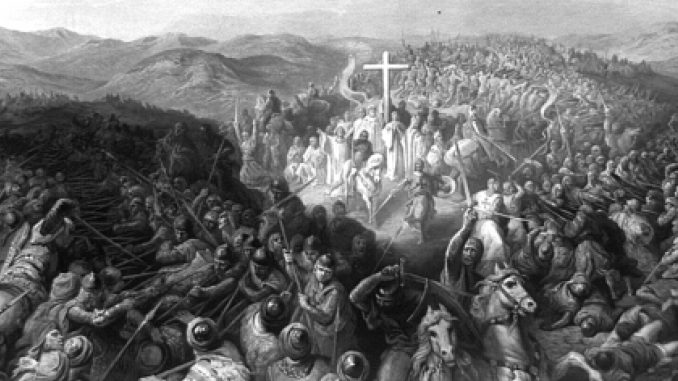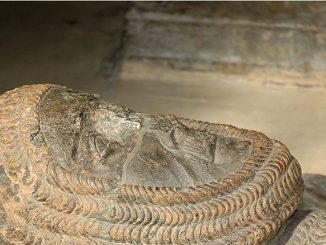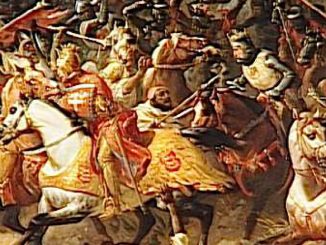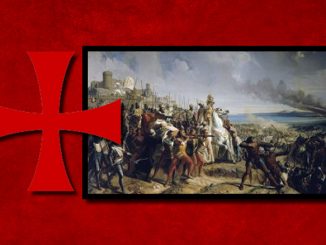
The Siege of Ascalon by Stephen Dafoe
Excerpted from the book Nobly Born: An Illustrated History of the Knights Templar
The Siege of Ascalon
On 25 January 1153, the Commander of the City of Jerusalem, along with the ten knights under his command, was guarding the True Cross as an army of Templars, Hospitallers, seculars and ecclesiastics made the march toward Ascalon. The massive army arrived at the walls of the port city with as many siege towers as King Baldwin could gather for the war that lay ahead.
Ascalon was situated on the Mediterranean coast and its fortifications were like a half circle; the radius on the shoreline and the semicircle on the landside facing eastward. William of Tyre described the city as being like a basin, that sloped seaward, girded round with artificial mounds, on which were built walls, studded with towers. The stone work, according to William’s account was held together with cement, which made them very strong. There were also four gates in the circuit of the city’s walls and one wall was flanked by two high towers.
The Franks besieged the city for months, their number added to at Easter with the arrival of pilgrims, including many knights and sergeants.33 The Fatimid garrison at Ascalon was aided in June by the arrival of troops from Egypt who had come by ship to bring fresh supplies. With fresh forces on both sides of the battle the siege continued on through the summer.
The largest of the Franks’ siege towers was so big that it rose a good distance above the city walls and allowed the Christians to rain volleys of missile fire down on the city with greater precision and accuracy.
On the evening of 15 August, some members of the garrison snuck outside and set the massive tower ablaze. However, they did not allow for the direction of the wind and soon the flames were not only destroying the tower, but weakening the city’s walls. The next morning the walls had become so weakened from the heat and several months of Christian battering that they collapsed, creating a breach that gave the Franks their first opportunity in nearly seven months to capture the city. When the dust began to clear the Christians were greatly excited that a victory was at hand and immediately picked up their arms to enter the breach. However, Bernard de Tremeley, who had succeeded Everard des Barres as Master of the Temple when the later resigned his post in 1152, arrived at the wall first along with a number of his Templars.
In his account of the siege, William of Tyre said that de Tremeley would not let anyone into the breach except his own men so that they could have first pick in obtaining the spoils of war. Although William was in France during the actual siege of Ascalon and writing as much as a quarter century after the actual event, the custom at the time was still the same as it had been when Ascalon was besieged. Whenever a city was captured by force, whatever a man seized belonged to him and his heirs in perpetuity. So there was certainly precedent for the practice among secular knights and although the Templars were vastly different to secular knights in many ways, it is reasonable to assume that de Tremeley would have wanted to obtain as much reward for his Order’s efforts as possible. In fact the papal bull Omne datum optimum had among its many privileges expressly given the Templars the right to keep booty captured from the Muslims and it is certain the Templars would have taken full advantage of this privilege.
De Tremeley entered the breach with about forty of his Order, and it was said that those who remained outside the breach did so to keep others from getting in until the Templars got their share of the booty. Unfortunately for de Tremeley and his men, forty Templars, no matter how well trained, were no match for the awaiting garrison who slew the invaders to a man as soon as they realized that the odds were in their favour. Realizing that no further Christians were following, they moved quickly to secure the breach by piling beams and other pieces of good sized timber across the hole. As the fire of the previous night had now died out, they once again resumed their positions in the towers and renewed their defence immediately.
Soon the Muslims were not the only ones looking down on the Christians from above – the slain Templars were tied to ropes and hung over the city’s walls to taunt the Christians.
As was often the case in medieval warfare, a truce was called so that each side could bury its dead. Although the battle later resumed, the Muslims had soon had enough and terms of surrender were sought. The Christians accepted the proposals and gave the citizens of Ascalon three days to vacate the city. They were gone within two and the captured city was given to Baldwin’s younger brother Amalric.
Although it would be easy to accept William of Tyre’s assertion that Master Bernard de Tremeley and his Templars acted in their own interests at Ascalon, his is the only account of the battle to make such a claim. Given that William was not an eyewitness to the events and did not always see eye to eye with the Templars, it is possible that his account, derived from second hand sources, was manipulated to deliver his own message. What is known is that the Templars lost a number of men during the siege, including their Master Bernard de Tremeley.
Once again, as they had several times previously, the Order assembled thirteen of their number to elect a new Master and this time chose the Order’s Seneschal, Andrew de Montbard, perhaps the last of the Order’s founding members, to be the Templars’ Grand Master.
About Us
We hope you enjoyed this article on the Siege of Ascalon.
TemplarHistory.com was started in the fall of 1997 by Stephen Dafoe, a Canadian author who has written several books on the Templars and related subjects.
Read more like the Siege of Ascalonfrom our Templar History Archives – Templar History



